Observing celestial objects with a telescope is a thrilling activity for astronomy enthusiasts, and one of the most intriguing subjects is the International Space Station (ISS). The ISS orbits Earth at an astonishing speed, and its appearance as a bright, fast-moving object makes it an attractive target for those curious about what might be visible through a telescope. It makes you wonder, “Can you see ISS with telescope?”
Yes, you can see the ISS with a telescope, but it is challenging due to the space station’s speed across the sky. You will find it easier to observe the ISS using binoculars or even with the naked eye, provided you know when and where to look. A low-power eyepiece with a wide field of view can help spot the ISS with a telescope. Still, tracking it is challenging.
In this article, you get
An ultimate guide on how to observe the ISS
Where to find the ISS in the night sky
When to go for Earth observation of the International Space Station
Telescope requirements to see the ISS
Helpful apps and websites to view the ISS from telescope
Tips on photographing the ISS
By the end of this article, you’ll have all the info you need to see the ISS with a telescope and more!
Let’s dive right in.
Can You See ISS with Telescope? Overview
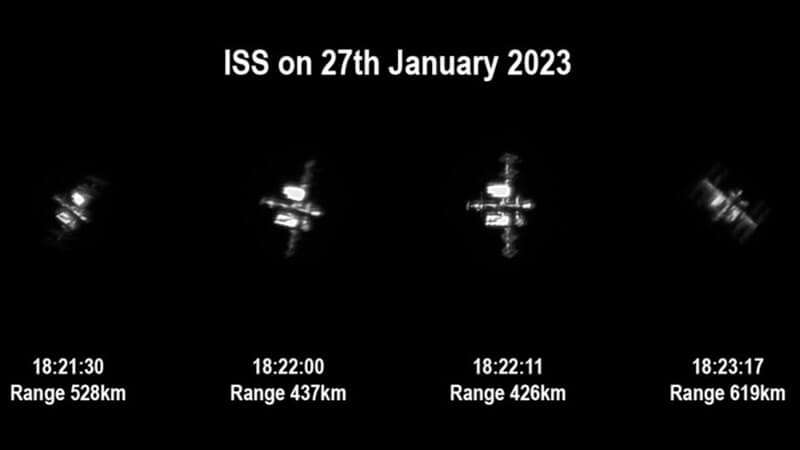
Setting up a telescope specifically designed for tracking a satellite in low earth orbit, equipped with a finderscope, substantial magnification, and a stable mount, can improve the chances of capturing a detailed view of the ISS.
However, even with the appropriate equipment, observing the ISS through a telescope still requires patience and practice.
What is the International Space Station?
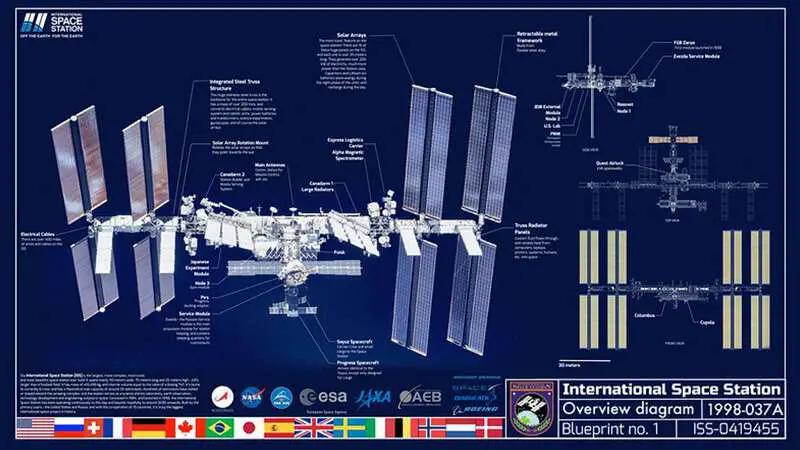
The International Space Station (ISS) is a large spacecraft orbiting Earth.
It serves as a home for astronauts and a lab for science experiments in microgravity. Many countries have joined forces to build it and utilize its resources.
The ISS is located about 250 miles above Earth’s surface, traveling at a staggering 17,500 mph. Constructed with multiple pieces, astronauts assembled the ISS in space. It is now the largest human-made object in outer space.
Visible from various locations worldwide, the ISS is the third brightest object in the night sky after the Moon and Venus. According to NASA, it can be seen with the bare eye as a steady, fast-moving white pinpoint of light, even from city centers.
Telescopes and Observing ISS
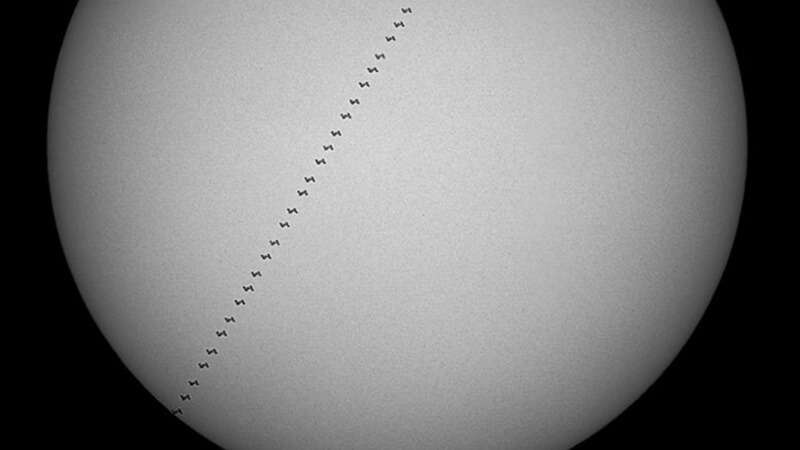
When observing the International Space Station (ISS) with a telescope, having the right telescope with suitable specifications. This section will discuss the types of telescopes and the recommended specifications for observing the ISS.
Types of Telescopes
You can broadly classify telescopes into three categories:
- Refractor telescopes
- Reflector telescopes
- Catadioptric telescopes
Refractor telescopes use lenses to gather and focus light, while reflector telescopes use mirrors. Catadioptric telescopes combine both, using lenses and mirrors in their design.
If you’re new to the world of telescopes, read my articles geared toward amateur astronomers:
- What is a Newtonian Telescope?
- Refractor vs. Reflector Telescope
- Dobsonian vs. Newtonian Telescope
- Keplerian vs. Galilean Telescope Design
- Why is my telescope upside down?
Telescopes with good tracking capabilities are better for observing fast-moving objects like the ISS. A reflector telescope is a suitable choice.
Recommended Specifications
To effectively observe the ISS, your telescope should have certain key features.
- Design: it should be designed for tracking, allowing you to keep up with the fast motion of the ISS.
- Mount: a stable mount is vital to avoid shaky views.
- Magnification: telescopes with 100x magnification and a finderscope can provide better visibility of the ISS.
- Eyepiece: Low-power eyepieces that offer a wide field of view can make it easier to track the ISS.
Remember that tracking the fast-moving ISS with a telescope may still be tricky. It would help if you considered opting for a pair of binoculars.
Preparing for Your Observation
In this section, I’ll guide you through preparing to observe the International Space Station (ISS) through a telescope. With some planning and the right equipment, you can have a great experience viewing the ISS as it orbits Earth.
Finding ISS in the Sky
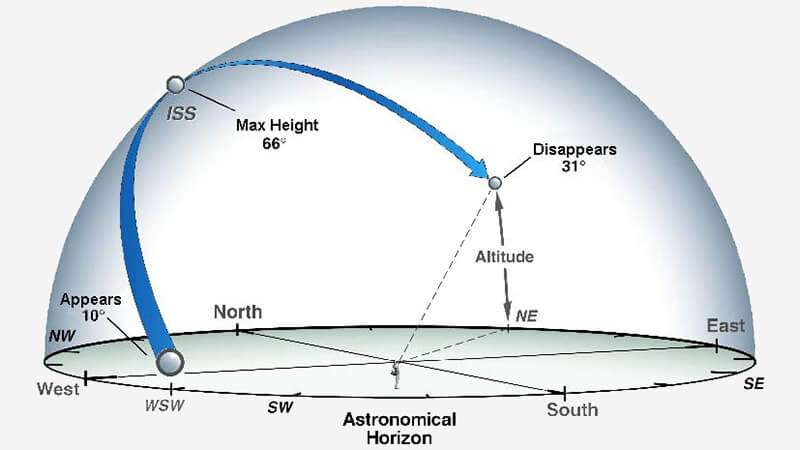
Begin by finding out when the ISS will be visible from your location.
NASA’s Spot The Station is a valuable resource for determining the time and direction of the ISS’s appearance.
I list additional resources at the end of this article.
Once you have this information, it’s a good idea to practice spotting the ISS with the naked eye before attempting to observe it through a telescope. The ISS looks like a fast-moving plane but much higher, traveling thousands of miles an hour faster.
Note the direction it will appear (e.g., southwest or northwest). Knowing its direction will help you understand where to point your telescope.
Timing and Location
The perfect moment to spot the ISS is when it rises above the horizon, so be ready at the specified time. Choose a location with minimal light pollution, a clear sky, and a clear horizon view toward the ISS’s appearance. You’re looking for a dark sky free of clouds.
Set up your telescope on a mount, and align your finder.
Use a low-power eyepiece with a magnification of around 100x for a wide field of view. A wide field of view will make it easier to follow the ISS as it moves quickly across the sky.
Once you have successfully located the ISS, follow it with your finder scope and position your telescope in front of it. Observe it through the eyepiece as it passes.
Remember, the ISS moves quickly, so make the most of your time to view it.
Tips for a Successful Observation
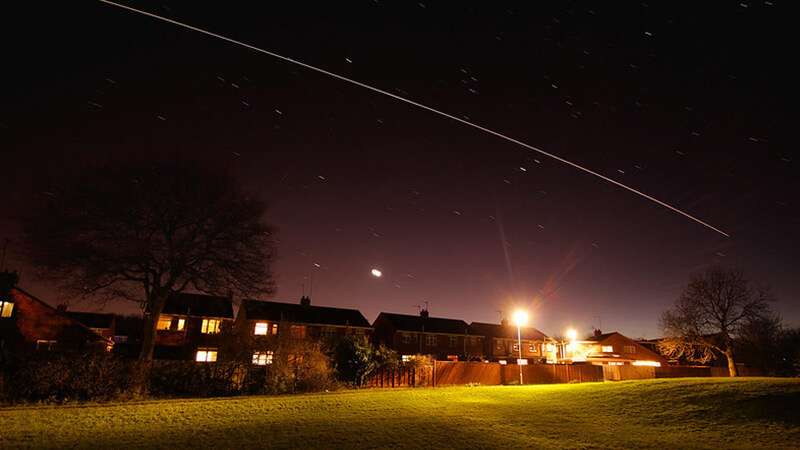
Tracking ISS
To increase your chances of spotting the ISS:
- Choose a day when it is visible for a few minutes.
- Find the best location near you with minimal light pollution.
- Keep an eye on weather conditions; clear skies are essential for successful observation.
Adjusting Your Telescope
Be prepared to make quick adjustments as the ISS races across the sky. Place your telescope on a mount and align your finder when observing the ISS. Once you have the ISS in sight, manually adjust your telescope to follow it as it passes your crosshairs.
Some tips for telescope adjustments:
- Start with a low-power eyepiece for a wider field of view
- Practice adjusting the telescope swiftly and smoothly
- Consider using a motorized mount for smoother tracking
With the proper preparation and adjustments, you may be able to see the ISS’s distinctive “T-shape” with your telescope. Remember, patience is vital; continue observing and adjusting your telescope as needed to maintain the best possible view of the ISS.
Alternative Methods of Observing ISS
Aside from using a telescope, there are several other ways to observe the International Space Station (ISS). In this section, I’ll discuss three alternative methods:
Naked Eye Observation
You don’t need any special equipment to see the ISS. It is the third brightest object in the sky. You can see it with the naked eye.
Find out when it will pass your location and look at the right time in the right direction. The ISS resembles a fast-moving aircraft but is much higher up and faster.
Binoculars
For a closer look, try using binoculars. They’re much easier to maneuver than a telescope, and the ISS’s high speed won’t be as problematic.
Through binoculars, you can even notice the colors of the ISS.
Live Streams
Live streams are available if you’d rather observe the ISS from the comfort of your home. These streams showcase views from the ISS itself or use high-powered telescopes to follow the ISS in its orbit. You can find various streams on platforms such as YouTube.
Photographing the ISS

If you want to photograph the ISS through a telescope, there are a few things you’ll need to keep in mind. Here’s how to do it:
- Choose the right equipment: You’ll need a telescope with a motorized mount and a camera capable of taking long exposures. A DSLR camera attached to your telescope or with a telephoto lens is a good choice.
- Set up your equipment: Mount your camera to the telescope and align the telescope’s tracking system with the ISS’s path. You can use software like Stellarium to help you do this. See the next section for applications and websites to find the ISS.
- Choose the proper settings: Set your camera to manual mode and choose a high ISO, a wide aperture, and a long shutter speed. Experiment with different settings to find the best combination for your equipment.
- Wait for the right time: The best time to photograph the ISS is when it’s passing overhead at dawn or dusk. Check online resources like NASA’s Spot the Station to find out when and where the ISS will be visible from your location.
- Take the photo: Take photos as soon as the ISS enters your field of view. Use a remote shutter release or a timer to minimize camera shake.
- Review your photos: After taking them, review them to see if you captured the ISS. You may need to adjust your settings or try again at a different time.
- Edit your photos: Use photo editing software to adjust your photos’ brightness, contrast, and color. You may also crop your images to focus on the ISS.
- Share your photos: Share your photos on social media or online forums to show off your skills and inspire others to try photographing the ISS.
Remember, photographing the ISS through a telescope can be challenging, but with the right equipment and patience, you can capture stunning images of this fantastic space station.
Applications and Websites to observe the ISS
Here are some apps and websites to help you track and observe the ISS:
- NASA’s Spot the Station: This website provides information on when and where the ISS will be visible from your location. You can sign up for email or text alerts to be notified when the ISS will be visible.
- ISS Detector: This ISS tracker app for mobile devices provides real-time tracking of the ISS and other satellites. It includes a map view and alerts for upcoming passes.
- GoISSWatch: This app for iOS devices offers real-time tracking of the ISS, an overhead sky view, and alerts for flyovers.
- Heavens-Above: The heavens above website provides information on when and where the ISS and other satellites will be visible from your location. It includes a map view and detailed information on each pass.
- SkySafari: This app for iOS devices is a powerful astronomy tool that includes a feature for tracking the ISS and other satellites. It consists of a map view, alerts for upcoming passes, and detailed information on each pass.
With these resources, you can enhance your ISS observation experience and stay updated on its position in the sky.
Frequently Asked Questions
What magnification is needed to see the ISS?
To see the International Space Station (ISS) through a telescope, you need a magnification of at least 100x. However, the ISS moves quickly across the sky, so I recommend a telescope with a wide field of view.
How do you follow the ISS with a telescope?
To follow the ISS with a telescope, you need to track it manually. You can do this using a motorized mount or adjusting the telescope’s position as the ISS moves across the sky. It’s essential to keep the ISS in the center of the telescope’s field of view to get the best view.
What does ISS look like through a telescope?
Through a telescope, the ISS looks like a bright, moving dot of light. You can see some details, such as the solar arrays or the space station’s shape, but it won’t be easy to see any fine details.
What telescope is best for ISS?
The best telescope for viewing the ISS has a wide field of view and a motorized mount. A refractor telescope with a short focal length is ideal, as it will provide a wide field of view and allow you to track the ISS easily.
Is it possible to see the ISS without a telescope?
Yes, it is possible to see the ISS without a telescope. The ISS is visible to the unaided eye as a bright, moving dot of light. It’s easiest to see the ISS when it passes overhead at dawn or dusk when the sun reflects off the space station.
Why can’t we see the ISS every night?
We can’t see the ISS every night because its orbit takes it over different parts of the Earth at different times. The ISS orbits the Earth about once every 90 minutes, so it’s only visible from a particular location for a short period each day.
How do I know if I saw the ISS?
If you saw a bright, moving dot of light in the sky, you may have seen the ISS. You can confirm this by checking online resources, such as NASA’s Spot the Station website, which provides information on when and where the ISS will be visible from your location.
Summary: international space station telescope
Thank you for reading my article “Can You See ISS with Telescope.”
Seeing the International Space Station (ISS) with your eyes is possible without a telescope. The ISS is visible from Earth as it orbits around our planet. You need to know when and where to look.
First, find the right time and location to catch a glimpse of the ISS. Various websites and apps can help you with this. Next, go outside and find a clear, unobstructed sky view. The ISS moves quickly, so be ready to spot it when it comes.
A telescope can enhance your experience by providing a closer view of the ISS. However, it is not necessary to see the ISS. A pair of binoculars can also improve your viewing experience, offering more detail.
So, head outside at the right time, look up, and enjoy the sight of the ISS flying overhead. It’s an extraordinary experience that brings the wonders of space exploration a bit closer to home.




